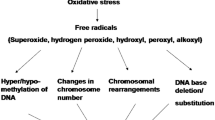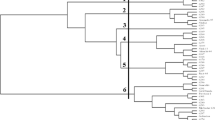Abstract
To control the genetic quality during the whole process of tissue culture of the traditional Chinese medicinal plant, Saussurea involucrate Kar. et Kir., DNA polymorphisms and genetic variations were investigated using randomly amplified polymorphic DNA (RAPD) and inter-simple sequence repeats (ISSR) markers. The genetic stability/variation in tissue-cultured products, including three calli, three adventitious shoots, regenerated plantlets and 2 year-old regenerated plantlets cultivated in the planting base in Tianshan Mountain, were assessed compared with 1 year-old and 2 year-old seedlings cultivated in the same planting base using aseptic seedlings as reference. Apparent genetic variation was detected in the 11 type of plant materials. The percentages of polymorphic bands in the RAPD and ISSR analysis were, respectively, 35% and 33%. Cluster analysis indicated that the genetic similarity values calculated on the basis of RAPD and ISSR data among the 11 type of plant materials were respectively ranged from 0.823 to 0.995 with a mean of 0.878 and 0.825 to 0.974 with a mean of 0.885, which classified the samples into three groups. The similarity coefficient also revealed that differences among three calli were not remarkable by both RAPD and ISSR analysis, and only chemical components and growth properties needed consideration in the screening of callus used for the next redifferentiation studies. But there are remarkable differences among three adventitious shoots analyzed by ISSR markers. Therefore, RAPD and ISSR markers are efficient tools in genetic variation assessment and quality control in plant tissue culture process.




Similar content being viewed by others
References
Fu CX, Jin ZP, Yang R, Wu FY, Zhao DX (2004) Establishment of Saussurea involucrata hairy roots culture and plantlet regeneration. Chin J Biotechnol 20(3):366–371
Gould AR (1986) Factors controlling generation of variability in vitro. In: Vasil IK (ed) Cell culture and somatic cell genetics in plants. Academic Press, Orlando, pp 549–567
Guo WL, Gong L, Ding ZF, Li YD, Li FX, Zhao SP, Liu B (2006) Genomic instability in phenotypically normal regenerants of medicinal plant Codonopsis lanceolata Benth. et Hook. f., as revealed by ISSR and RAPD markers. Plant Cell Rep 25:896–906
Jaccard P (1908) Nouvelles recherches surla distribution florale. Bull Soc Vaud Sci Nat 44:223–270
Karp A (1991) On the current understanding of somaclonal variation in plants. Oxford Surv Plant Mol Cell Boil 7:1–58
Larkin P, Scowcroft WR (1981) Somaclonal variation, a novel source of variability from cell cultures for plant improvement. Theor Appl Genet 60:197–214
Larkin PJ, Banks PM, Bhati R, Bretell RIS, Davis PA, Ryan SA, Scowcroft WR, Spindler LH, Tanner GJ (1989) From somatic variation to variant plants: mechanism and applications. Genome 31:705–711
Mangolin CA, Ottoboni LMM, Machado PS (2002) RAPD markers to evaluate callus tissue of Cereus peruvianus mill. (Cactaceae) maintained in different growth regulator combinations. Biochem Genet 40:351–358
Murashige T, Skoog F (1962) A revised medium for rapid growth and bioassay with tobacco tissue cultures. Physiol Plant 15:473–497
Peschke VM, Phillips RL (1992) Genetic implication of somaclonal variation in plants. Adv Genetics 30:41–75
Piao RZ, Cao HN, Chen YQ, Jin YS, Zong CW (2003) Study on the technology of rapid propagation in vitro for saussurea involucrata kar. et kir. Chin J Agr Sci Yanbian Uni 25(2):117–121
Rohlf FJ (2000) NTSYS-pc: numerical taxonomy and multivariate analysis system. Exeter Software, New York
Thomas JB, Vijayan D, Joshi SD, Lopez SJ, Kumar RR (2006) Genetic integrity of somaclonal variants in tea (Camellia sinensis (L.) O Kuntze) as revealed by inter simple sequence repeats. J biotechnol 123:149–154
Wa G, Liu JL, Shi YH (1990) Tissue culture of Saussurea involucrata. Chin XinJiang Ind Sci 5:221–222
Wu LQ, Guo SX, Xiao PG (2005) Tissue culture and plantlet regeneration from embryo of Saussurea involucrata. China J Chin Materia Medica 30:814–816
Xie ZB, Jiang GF, Liao FS, Yue ZG (2007) Advances in studies of chemical composition and medicinal value of snowdrop. Chin Food Sci Technol 6:254–257
Yang H, Tabei Y, Kamada H, Kayano T, Takaiwa F (1999) Detection of somaclonal variation in cultured rice cells using digoxigenin-based random amplified polymorphic DNA. Plant cell Rep 18:520–526
Zhao HQ, Wang XJ (2008) Establishment of rapid propagation technique in tissue culture of Saussurea involucrata Kar. et Kir. from Tianshan Mountain. Chin J Anhui Agr Sci 36(7):2743–2744
Zhao B, Xu CM, Wang YC, Yuan XF, Lei L, Wang XD (2005a) Callus induction and rapid propagation technique of regenerated plantlets of Saussurea involucrata. Chin Invention Patent, Application No. 200510012283.2
Zhao B, Wang, XJ, Xu CM, Wang YC, Liu M, Bolati, Yuan XF, Zhao HQ, Wang XD (2005b) Large-scale artificial cultivation of regenerated plantlets of Saussurea involucrate. Chin Invention Patent, Application No. 200510012284.7
Zou YP, Ge S, Wang XD (2001) Molecular markers in systematic and evolutionary botany. Science Publisher, Beijing, pp 16–17
Acknowledgements
This study was supported by the National Natural Science Foundation of China (20506027) and Hi-tech Program of Western Plan of Chinese Academy of Sciences (KGCX2-YW-509).
Author information
Authors and Affiliations
Corresponding author
Rights and permissions
About this article
Cite this article
Yuan, X.F., Dai, Z.H., Wang, X.D. et al. Assessment of genetic stability in tissue-cultured products and seedlings of Saussurea involucrata by RAPD and ISSR markers. Biotechnol Lett 31, 1279–1287 (2009). https://doi.org/10.1007/s10529-009-9984-6
Received:
Accepted:
Published:
Issue Date:
DOI: https://doi.org/10.1007/s10529-009-9984-6




